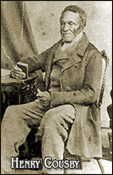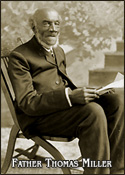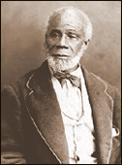Owen Sound's Black History

Black Owen Sounders of Note
The history of Owen Sound is incomplete without the inclusion of the contribution of its Black citizens. Some are famous beyond the borders of the City. Others are famous locally for their contribution to the development of Owen Sound as a city.
In the 1870s, 10% of the city’s population was Black (672 people).
Addie Aylestock
In 1951, Addie was the first black female to become an ordained minister in Canada. She served as a minister of the Owen Sound British Methodist Episcopal Church.
The Cousby Family
As part of Owen Sound’s early business community, the Cousbys were extremely clever and creative. In the 1850s, the Cousbys moved from Toronto to Artemesia, finally settling in Owen Sound. Henry, the father, found work as a labourer and a confectioner. His son, Jeremiah Senior, tried his hand at various jobs before choosing the retail trade and running his own confectionery (sweet shop) on the Butchart Block of Owen Sound’s main street. Ice cream and Coca Cola made the shop a popular spot. In fact, Cousby’s was the first Owen Sound business to sell Coca Cola.
Jeremiah’s wide variety of merchandise led to his success as a shop owner, although one of his products, Cousby’s “Hair Restorer” was not a roaring success. Jeremiah was voted the most popular merchant in Owen Sound in 1907; at this time, his confectionery was located on the west side of the city.
Jeremiah’s son, Jerry, chose to apply himself to an education and became a lawyer. Not only did he practice law, he was co-owner of the local newspaper, the Owen Sound Sun (1897-1899). In the early twentieth century, Jerry headed to the Alaskan frontier to seek his fortune, where he later died.
Tommie
Earlls
Born and raised in Owen Sound, Tommie played solo trumpet and was leader of the band, Tommie Earlls and His All-Time Stars. He played with Oscar Peterson and Louis Armstrong, among others. His film and television career has cast him in productions with actors such as Lou Gosset Jr., Danny Glover and Charlie Sheen.
John Green
A slave in Baltimore, Maryland, Thomas chose to escape to Canada in the early 1850s after a quarrel with his owner. If he stayed, he knew he would either be sold or beaten. After he arrived in Owen Sound in 1856, he married Mary Ann Gordon, the daughter of an African father and an English mother. For a while, John moved his family to Artemesia Township to work on his farm. In 1870, his ill health forced a return move to Owen Sound. John and Mary Ann’s seven children all attended the Boyd Street School (later known as Ryerson). John, who ran his home on religious principles, was often a preacher at the BME Church.
Samuel George Harrison
Samuel George Harrison was raised by his grandparents, Mr. and Mrs. James Douglas of Williamsford. He moved in with them when he was a toddler, about one-and-a-half years old. His parents had just moved to Sydenham (Owen Sound). He farmed for a few years with his grandfather near Jones Falls, then Samuel George moved to Owen Sound to live with his mother and 15 younger brothers and sisters, including William Henry. He eventually married Priscilla Courtney, and had three children. They were active members of Owen Sound’s BME Church.
His early career in Owen Sound included work on many of the early boats, including the Francis Smith and the Silver Spray. As a deck hand, he sailed on several, such as the Campana and the Athabasca. He worked in the building industry too, hauling stone and mortar for St. George’s Church and working on several other early Owen Sound buildings. As a young man, he trained as a butcher with William Wooten and worked for him for several years. He found employment with many of the community’s butchers over the course of his life. Butchers in Owen Sound at that time included Alex Spears, Wilkinson and Boyd, Ben Hopkins and Brignell. He remained active in the butcher trade until well into his seventies, when failing eyesight forced his retirement.
William
Henry Harrison (1866-1951)

William Henry Harrison was an Owen Sound quarryman who, through his career, made a significant contribution to the construction of many City buildings. When he was two years old, he moved to Owen Sound with his parents, Mr. and Mrs. Samuel George Harrison, from Washington, D.C. He married a Williamsford girl, Martha Douglas; a Sun Times article reported the celebration of their 64th wedding anniversary.
He and his brother, Samuel George, learned the butcher trade from W. Wooten, a butcher on the main street. William Henry, however, found he preferred working in stone. He worked as a foreman at the Oliver-Rogers Co. Stone Quarry, but soon owned his own quarry on the east hill. As Owen Sound grew, so did the demand for well-constructed and attractive buildings. William Henry quarried the stone, plugged and feathered stone for the First Baptist Church, the sills, lintels and base stones of the Church of Christ (Disciples) and St. George’s Church, as well as the tower vestibules of the Division Street Church.
Stone from his quarry was used in the stone cross, name stone and the building of St. Mary’s High School. His quarried stone was used in most of the store buildings constructed to replace the earlier clapboard ones. It was also used in the early cement plants, the footing stone for the Keenan plant, and the east side foundry. His stonework is still visible throughout the city on many of its heritage buildings. The stone his quarry produced was also shipped across Canada.
One of William Henry’s most impressive jobs took him out of the City of Owen Sound to Sault Ste. Marie, where he was in charge of quarrying, plugging and feathering the stone used in the construction of the locks.
“Daddy” Hall (1783-1900)

Perhaps the best-known Black Owen Sounder is John “Daddy” Hall. He is also credited with being the first Black settler in the fledgling settlement of Sydenham.
John Hall was born a free Black in Amherstburg, Ontario in 1783. His father was a full-blood Mohawk and his mother was an escaped slave, living free in Upper Canada (Ontario). When still a child, he, his mother and his 11 brothers and sisters were captured by slave traders and sold separately to Kentucky plantation owners. His father was away from home at the time. John never saw any of his family again. Sold to a plantation owner named Catlett, he married a young slave on the same plantation; shortly after, the pair escaped on the Underground Railroad and made their way to Canada. He and his family lived for a short time in the southern part of Upper Canada before moving to the Rocky Saugeen (Durham) area and then settling in Sydenham in the 1850s.
Daddy cleared a plot of land on the east hill, later the “Pleasure Grounds”, and what is today’s Victoria Park. He felled the trees and constructed a log shanty for a home. About 10 families lived in this little community. Daddy maintained “squatter’s rights” to his little piece of land until his death in 1900.
During his lengthy life, Daddy was a popular and well-known figure in the community. As town crier for almost 50 years, he was the community’s “walking newspaper”. He announced auction sales, upcoming court cases, upcoming entertainments, and the day’s news. He followed the same routine each day: at 10 a.m., he stood at the corner of 3rd Avenue and 10th Street East, rang his bell with his characteristic flourish and shouted out his message. From there, he moved to the corner of 10th Street and 2nd Avenue East, ringing his bell as he travelled between his posts. He continued in the same manner in the middle of the block between 10th and 9th Streets, then at the corner of 9th Street and 2nd Avenue East. He then went back to the middle of the block, and completed the circuit at the Market Square. He repeated his route again at two each afternoon, ending each announcement with “God Save the Queen”.
John earned the nickname of “Daddy” as he is said to have fathered up to 21 children, and reports state he was married at least 3 times, perhaps as many as 5 before passing away at the age of 117. Hundreds of people attended his funeral.
James Henson (Charley Chance)

Born as Charley Chance, James Henson changed his name on becoming a free man. He was born on a plantation near Baltimore. As a young man, he escaped from slavery in the 1840s, made his way to Canada and Owen Sound, where he lived for about 60 years. He met “Daddy” Hall in the Southern US several times before his escape.
James had married in slavery, but his wife chose to not to escape. After his escape, he remarried, and lived in Philadelphia, New Jersey and New York State before heading to Canada. His wife and family stayed behind in Maryland, while he headed to Artemesia in Canada West to claim his free 50 acres of land being given out by the Queen. Upon his arrival, however, he discovered the last lot had been given away. He chose to stay, and settled in Owen Sound. He worked as a labourer and became known as “Dad” Henson in the community.
James is the main character of the book, “Broken Shackles”, written by John Frost, Jr., from a prominent white Owen Sound family with strong Black sympathies. Like his father before him, John was mayor of Owen Sound. The photo of James on the front cover of the book shows him perched on his wheelbarrow, taking a break from his work, while eating a watermelon. The watermelon was given to him by a man named Edward Ferguson, on the condition that he eat the whole thing. A passing photographer snapped his photo; a preacher of the American Episcopal Church recognized the name with the photo and, as a result, James was reunited with his wife, who was still living in Maryland.
Josiah Henson
Josiah Henson, as the probable model for Harriet Beecher Stowe’s “Uncle Tom” in Uncle Tom’s Cabin, is the best known of all Black Canadians. Born as a slave in Charles County, Maryland, he was bought and sold three times before he was eighteen years old. Cheated out of his chance to buy his freedom, Josiah, his wife and four children escaped to Canada. He founded an all-Black community near Chatham, Ontario, and taught ex-slaves how to successfully survive by farming.
In “The Life of Josiah Henson”, he wrote of his own escape from slavery in 1849. It is generally thought he resided in Owen Sound for a brief time. While in Owen Sound, he worked with the Reverend Robert Robinson, the Congregationalist minister, whose church was located at 1st Avenue and 9th Street West.
Josiah’s home in Dresden, Ontario, was opened as a museum in 1948.
Father Thomas Henry Miller

Father Miller was a lay preacher with the fledgling British Methodist Episcopal (BME) Church in the Village of Sydenham (now Owen Sound) in the years before an ordained minister served the congregation. In the years that followed, he continued to preach during the periods an ordained minister was not appointed to the church.
To support his family, he painted and worked a little plot on 4th Avenue West. According to an article that appeared in The Daily Sun-Times on February 21, 1942, Father Miller was “an outstanding Christian character” and a “compelling speaker”.
Marisse Scott
Marisse Scott, an Honours graduate of an Owen Sound high school was Canada’s first black nursing graduate in 1950.
Earlier, in 1947, the Owen Sound General and Marine Hospital refused her entry to its nursing program, stating “Sorry—we don’t accept colored girls”. A great deal of press coverage ensued, expressing Marisse’s bitter disappointment. With the assistance and support of Father J.A. O’Reilly, pastor of the Church of Our Lady in Guelph, Marisse was accepted at Guelph’s St. Joseph’s Hospital. Marisse passed the nurses’ aptitude test with no difficulty whatsoever. She continued to be at the top of her class during the three-year course. Hospital authorities stated she was “one of the most willing—and able—student nurses in the history of the institution…”
While at St. Joseph’s, Marisse met veterinary student Greaham Louisy, whom she later married. They settled on the island of St. Lucia, where Marisse was the head of the health ministry’s nutrition department.
Ned Patterson

Ned Patterson drove a stagecoach in Owen Sound’s early days, from Owen Sound to Meaford. His cargo included passengers, mail, and other freight. He also had a stint at the City Hotel (later the Paterson Hotel), where he drove the hotel “bus”. His roughcast home was just south of the Dowsley Carriage Works. He had one son named Ned.
He was also a lay preacher in the British Methodist Episcopal
Church.
Mary Taylor

Mary Taylor was born into slavery and worked as a field hand on a plantation. She escaped slavery and settled in the Village of Sydenham (now Owen Sound). One of the most popular citizens in the settlement’s early days, Mary was good-humoured and good-natured. On October 1, 1932, she is described in a local newspaper article as “about five feet high and three feet broad”. Her husband, John, was a blacksmith and she was just as strong as he was, able to swing the sledgehammer as well as he. She loved to challenge young men to wrestling contests, and then win!
Mary’s specialty was apples; she always carried a basket of them with her. She also sold oranges and sweets. Eventually, she opened an eatery and store near the 8th Street bridge on the Sydenham River, close to the Market Square. She sold pies, fruit and oysters and often peddled her wares in the county courthouse. She became known as “Grannie” Taylor.
She was a woman of strong religious beliefs, ardently supported the BME Church and worked hard to collect funds for the “Little Zion” Church.
Carl H. Woodbeck
One of Father Miller’s grandsons, Carl H. Woodbeck, was, at one time, the chief travelling church worker for the BME Church. He was also, at one point, the chief editor of Africa Speaks, which carried the tagline of the “voice of the colored man in Canada.”
Wilson Woodbeck
Wilson, Carl’s brother, sang in the church choir as a boy and went
on to become an opera singer, singing baritone. He sang in Carnegie Hall
in the early 1940s. His programme included many of the spirituals originally
sung on the slave plantations. Wilson’s successful career included
work with the National Negro Opera Company and the Negro Actors Guild Equity.

